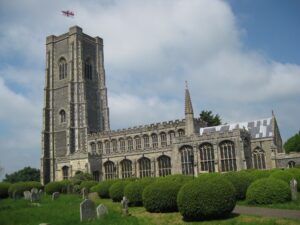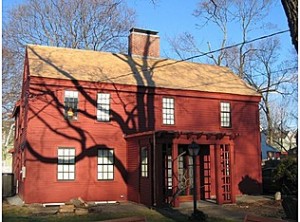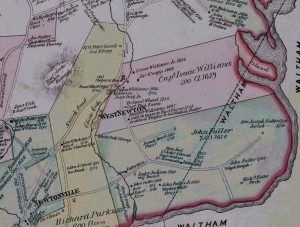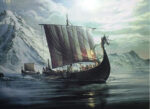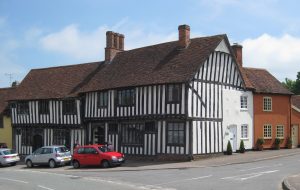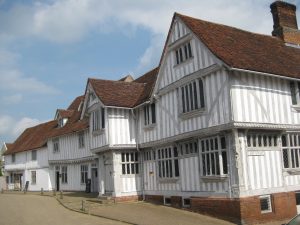Who is John Fuller of Newton
John Fuller, who died and was buried in 1698 in Newton, Massachusetts, USA, was one of the early English immigrants to New England and almost certainly came as a fully qualified Maltster, likely with the intention of establishing a business to apply his trade. Beer was the drink of choice at the time until
coffee became the favorite. In 1655, he purchased 9 acres in Watertown, which would have given him the space needed for a Malt House and grain storage bins. However, he sold that property in 1657 for £46 as he may have found the possibility of buying a farm on the south side of river, where he would have space not only set up his business, but to grow his own grain. It is possible the down payment of £92 for this 750 acre land purchase in 1658 was largely saved from his occupation as a Maltster. Some information…..
John’s wife, Elisabeth Cole was born in Lavenham, Suffolk, England, UK and was baptized in the St Peter and St Paul Parish Church Jan 1, 1622/3. John Fuller of Newton Emigrated from Lavenham Parish to Cambridge, Massachusetts, USA More….. Lavenham
Elisabeth’s father, Walter, left 20 shillings to his daughter, Elisabeth in his will, proved in 1653; “the nowe (sic) wife of John Fuller in New England” and with those few words the descendants of John Fuller of Newton knew the ancestry of both John and Elizabeth. Walters Will
John of Newton was one of the three ‘John Fullers’ who immigrated to New England prior to 1650 and all three married an “Elizabeth” and named their first son “John”. So it is no wonder that the history books of the time mixed up their lives. More…….3 John Fullers
Children
The first documented evidence of the John Fuller family in New England is the birth record of their fourth son, Joseph, 10 Feb, 1652/3 and therefore the first three children were likely born in England as was his marriage to Elizabeth Cole. John and wife Elizabeth, had 8 children of which 7 lived to have families of their own. The official Vital Records of Massachusetts show no birth record for the first three children (John Jr., Elizabeth & Jonathan) however we find them in the Births section of the “Town” Vital Records for Newton (b. about 1645, 1647 & 1648). The Vital Records for Cambridge do record the births of the remaining five children (Joseph 1652/3; Joshua 1654; Jeremiah 1658/9; Bethia 1661 & Isaac 1665). More……..children
First Settler
John Fuller is named as one of the first settlers in Newton, MA and his name is one of the 20 engraved on the North side of the ‘First Settlers Monument’ which was built in 1852 and stands in the East Parish Burying Ground Cemetery in Newton. More……first settlers monument
John and many of the descendants of John and Elisabeth can be found in the following cemeteries situated in Newton, Middlesex, MA, USA:
East Parish Burying Ground. Read More
West Parish Burying Ground. Read More
Newton Cemetery. Read More
Maltster
John Fuller was a Maltster by trade for which he would have apprenticed for 7 years in England; his Malt House is mentioned in his will.
At the time, Farming, Malting, Brewing and Selling Beer were all separate occupations. John of Newton was both a Farmer and a Maltster and would have increased his family fortunes both by owned land in the area and earning money through the profitable craft of supplying malt to the community for making beer. Many households brewed their own beer as this was the normal family beverage before the arrival of tea and coffee. More………..maltster
The Fuller Farm
In 1658, John Fuller purchased 750 Acres of land on the south side of the James River, which, throughout the history of Newton was known as the “Fuller Farm”. Over his lifetime, John accumulated some 1000 acres and set up each son with a farmstead at the time of their marriage. All five sons were bequeathed land within the original Farm area even though only three had farms within the area. John’s Will set out each son’s farm land and by the time of his death each son was already farming their land. In 1699, two years after John’s death, the five sons entered into an agreement to set out each son’s land ownership within the original Farm and set up a private roadway through the Farm. This agreement was the First Division of the Fuller Farm and stipulated land use rights. Each of these family farmsteads is located on the 1700 map of Newton which also shows the names of the farm owners as it was handed down generation after generation. More…….family farmstead map
Documents
We have accumulated the original of several family documents dating back to 1593 and where possible have placed a copy on this website. In cases where the Church of England owns the document, we have placed a transcribed version on the website. More………..documents involving the Fuller Family
Wills
Old Wills are a treasure trove of information for family researchers. During the process of transcribing the Wills of many of John’s descendants, we found several gems and even had to change our genealogy in several instances based on the information in these Wills. We have transcribed the Wills of John Fuller and each of his sons plus many of his Descendants.
John’s Will stipulated that “…and further my will is that my above said sons shall not allinate [alienate – to transfer ownership] the above given and granted lands unto any stranger until first the next relation of the above said Fullers have the offer of it;…..” More…….Wills for many of his descendants
DNA
The Y-DNA is passed from each direct male descendant to his sons and all the next generation’s sons down to living direct line male descendants today. Therefore, we know John Fuller of Newton’s Y-DNA as we have found six direct male descendant lines from John with the same Y-DNA. If you have the same Y-DNA, please contact us. More…….we know John’s YDNA
Did our John Fuller of Newton descend from the Mayflower Fullers – The answer is No – YDNA shows the Mayflower Fuller are haplogroup “R” vs ours which is “I”
John Fuller of Newton Descended from the Vikings
We know this because all known direct line Male descendants of John Fuller of Newton who have a
registered DNA, carry the same Y-DNA of I-253, which is primarily found in Scandinavia. What is Y-DNA More …. DNA – Origins
The period known as the ‘Viking Age’ covers the ninth to eleventh centuries when Viking Ships sailed out of Scandinavia across the northern hemisphere on voyages of piracy, conquests and settlement. Various Scandinavian groups invaded and occupied the east coast of England during the Viking Age and the Danish King was King of Denmark, Norway and England (Cnut the Great). More …… Vikings
Genealogy – Descendants of John Fuller of Newton
You have access to our data base information on a companion website with some 73,000 descendants and their spouses. There is a surname index where you can check to see if your family name is a descendant of John of Newton or you can look at the descendant tree to find your ancestors, assuming you are a descendant of John of Newton. You can follow one branch down 8 generations from John of Newton and you can also look through the family of John’s wife, Elizabeth Cole, this information was taken from the Lavenham, Parish Records. More………….search our genealogy website
Who was Simon Onge
Simon Onge was born 1619 in Lavenham, Suffolk, England, UK and his family was among the first settlers
of Watertown, Massachusetts, New England in 1631. After his mother died, Simon received a small farm in Newton from John Fuller and after Simon died in 1678, John penned a letter to the Probation court wherein he stated that he had lent Simon the land for Simon’s lifetime. The land in question was part of John’s deeded land and no sale document had been issued. However, the issue was the subject of two court cases and part of Massachusetts history. That letter and the description of the arrangement leads us to believe that John knew Simon very well as he would not have made such an arrangement with a stranger. We did not find any reference of this fact in the two court cases. More………Who was Simon Onge
Who was James Fuller of Lavenham
James Fuller was born about 1542 and raised his family in Lavenham, England. James died in 1622 and in
his will left property and money to his two children (John and Marie) as well as his four grandchildren (John Fuller the elder; John Mascall; John Fuller the younger and Suzan Fuller).
We have gathered evidence that links John Fuller of Newton to Lavenham and now through this Will of James Fuller, we will show that John fits into the James Fuller Family and is likely the grandson, John Fuller the younger. This leads us to conclude that the most likely ancestral line for John Fuller of Newton is back to James Fuller. More…….John’s grandfather
Puritans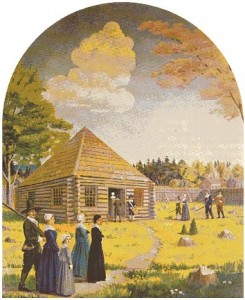
Seeking refuge and a new beginning for his fellow Puritans, John Winthrop joined the Massachusetts Bay Company in 1629 in England. Just one year later (1630) and ten years after the Mayflower, the first seven ships of that Company sail from England and Governor Winthrop, the first governor of Massachusetts Bay Colony, founded a settlement on the Shawmut peninsula which today is Boston, Massachusetts. More………..John Winthrop
About this Site
The five individual buttons along the bottom of the heading contain all the pages of the site.
To view a one page summary.

